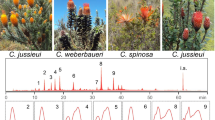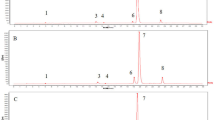Abstract
Angelicae sinensis radix is commonly used in Chinese medicine and is also widely used as a spice and condiment in many countries. Due to the different geographical sources and processing methods, the contents of chemical components are different and affect the quality of Angelica sinensis radix. A simple and efficient method was established to comprehensively evaluate the quality of Angelica sinensis radix by combining HPLC fingerprint and single-standard multi-component quantitative analysis. With ferulic acid as a single marker, the contents of eight main active ingredients, including ferulic acid, senkyunolide I, senkyunolide H, coniferyl ferulate, E-ligustilide, E-butylidenephthalide, Z-ligustilide, and Z-butylidenephthalide, were simultaneously determined in 30 min by reliable relative correction factor. The overall chemical profiles of Angelica sinensis radix were compared by fingerprint similarity evaluation, the specific content level of each component was compared by simultaneous content determination of multiple components of a single standard, and the specific different components of Angelica sinensis radix before and after processing were analyzed by chemometrics. The established method was successfully applied to the quality evaluation of 44 batches of Angelica sinensis radix from 4 different origins and 45 batches of Angelica sinensis radix with different processing methods. This study proposed a simple, rapid, low-cost, and reliable quality comprehensive evaluation method for ASR from different origins and processing methods, which may be readily transferred and applied to other industries.








Similar content being viewed by others
Data availability
The data that support the findings of this study are available from the authors, upon reasonable request.
References
National Administration of Traditional Chinese Medicine Editorial Committee (1999) Chinese Materia Medica. Shanghai Scientific and Technical, Shanghai
Chen XP, Li W, Xiao XF et al (2013) Phytochemical and pharmacological studies on Radix Angelica sinensis. Chin J Nat Med 11(6):577–587. https://doi.org/10.3724/SP.J.1009.2013.00577
Chinese Pharmacopoeia Commission (2020) Pharmacopoeia of the People's Republic of China. Chinese Medical Science and Technology, Beijing
Wei WL, Zeng R, Gu CM, Qu Y, Huang LF (2016) Angelica sinensis in China-A review of botanical profile, ethnopharmacology, phytochemistry and chemical analysis. J Ethnopharmacol 190:116–141. https://doi.org/10.1016/j.jep.2016.05.023
Zhou SS, Xu J, Tsang CK et al (2018) Comprehensive quality evaluation and comparison of Angelica sinensis radix and Angelica acutiloba radix by integrated metabolomics and glycomics. J Food Drug Anal 26:1122–1137. https://doi.org/10.1016/j.jfda.2018.01.015
Zhang K, Shen X, Yang L et al (2022) Exploring the Q-markers of Angelica sinensis (Oliv.) Diels of anti-platelet aggregation activity based on spectrum–effect relationships. Biomed Chromatograp 36(9):e5422. https://doi.org/10.1002/bmc.5422
Wei WL, Huang LF (2015) Simultaneous determination of ferulic acid and phthalides of Angelica sinensis based on UPLC-Q-TOF/MS. Molecules 20:4681–4694. https://doi.org/10.3390/molecules20034681
Xie TP, Liu N, Wang YL, Jing M (2020) Quality research progress of Angelica sinensis from different regions. Acta Chinese Medi Pharmacol 48(1):72–75. https://kns.cnki.net/kcms/detail/23.1193.r.20200113.1545.018.html
Gui QD, Zheng J (2019) Simultaneous determination of eight components in Angelica sinensis based on UHPLC-ESI-MS/MS method for quality evaluation. Biomed Chromatogr 33:e4326. https://doi.org/10.1002/bmc.4326
Zhang Q, Chen YY, Ma LX et al (2020) Study on the fingerprints and quality evaluation of Angelica Sinensis Radix by HPLC coupled with chemometrics based on traditional decoction process of ACPTCM. Dose-Response. https://doi.org/10.1177/1559325820951730
Razmovski-Naumovski V, Zhou X, Wong HY, Kam A, Pearson J, Chan K (2020) Chromatographic, chemometric and antioxidant assessment of the equivalence of granules and herbal materials of Angelicae Sinensis Radix. Medicines 7(6):35. https://doi.org/10.3390/medicines7060035
Li X, Yao YX, Wang XX, An C et al (2020) Quantification analysis of 13 organic components and 8 inorganic elements in Angelica Sinensis Radix and its different parts combined with chemical recognition pattern. J Anal Methods Chem. https://doi.org/10.1155/2020/8836184
Cai H, Cao G, Zhang HY (2017) Qualitative analysis of a sulfur-fumigated Chinese herbal medicine by comprehensive two-dimensional gas chromatography and high-resolution time of flight mass spectrometry using colorized fuzzy difference data processing. Chin J Integr Med 23:261–269. https://doi.org/10.1007/s11655-015-1966-z
Tian L, Yan HX, Fu XT et al (2014) Simultaneous determination of multiple components in decoction pieces of Chuanxiong Rhizoma and Angelicae Sinensis Radix by quantitative analysis of multi-components by single maker. Chinese J Pharm Anal 34(5):848–854. https://doi.org/10.16155/j.0254-1793.2014.05.018
Lou YJ, Cai H, Liu X et al (2014) Multi-component analysis in sun-dried and sulfur-fumigated Angelicae Sinensis Radix by single marker quantitation and chemometric discrimination. Pharmacogn Mag 10:S189–S197. https://doi.org/10.4103/0973-1296.127374
Yin HR, Ni H, Zhang LL et al (2021) Untargeted metabolomics coupled with chemometric analysis deducing robust markers for discrimination of processing procedures: Wine-processed Angelica sinensis as a case study. J Sep Sci 44(22):4092–4110. https://doi.org/10.1002/jssc.202100566
Liu C, Long HL, Wu XD et al (2021) Quantitative and fingerprint analysis of proanthocyanidins and phenylpropanoids in Cinnamomum verum bark, Cinnamomum cassia bark, and Cassia twig by UPLC combined with chemometrics. Eur Food Res Technol 247:2687–2698. https://doi.org/10.1007/s00217-021-03795-x
Lu WY, Niu YG, Yang HS et al (2014) Simultaneous HPLC quantification of five major triterpene alcohol and sterol ferulates in rice bran oil using a single reference standard. Food Chem 148:329–334. https://doi.org/10.1016/j.foodchem.2013.10.027
Hou JJ, Wu WY, Liang J et al (2014) A single, multi-faceted, enhanced strategy to quantify the chromatographically diverse constituents in the roots of Euphorbia kansui. J Pharm Biomed Anal 88:321–330. https://doi.org/10.1016/j.jpba.2013.08.049
Duric K, Liu Y, Chen SN et al (2019) Studying mass balance and the stability of (Z)-Ligustilide from Angelica sinensis helps to bridge a botanical instability-bioactivity chasm. J Nat Prod 82:2400–2408. https://doi.org/10.1021/acs.jnatprod.8b00962
Acknowledgements
This work was supported by Organizational Key Research and Development Program of Shanghai University of Traditional Chinese Medicine [Number 2023YZZ02]; Sanming Project of Medicine in Shenzhen (grant number SZZYSM202106004); National Key R&D Program of China under Grant [Number 2018YFC1707900 and 2018YFC1707001]; Research Project of Science and Technology Commission of Shanghai Municipality under Grant [Number 19DZ2200400].
Author information
Authors and Affiliations
Corresponding authors
Ethics declarations
Conflict of interest
The authors declare that they have no known competing financial interests or personal relationships that could have appeared to influence the work reported in this paper.
Compliance with ethics requirements
This article does not contain any research conducted by any author on human participants or animals.
Additional information
Publisher's Note
Springer Nature remains neutral with regard to jurisdictional claims in published maps and institutional affiliations.
Supplementary Information
Below is the link to the electronic supplementary material.
Supplementary file 1: Table S1.
The information of 89 batches of medicinal materials, raw decoction pieces and wine-processed Angelicae Sinensis Radix samples. Table S2. The parameters of the optimization for sample preparation. Table S3. The content (%) of the eight analytes with different extraction solvents. Table S4. The stability (%) of the eight analytes in 34 hours. Table S5. The system suitability parameters of different columns. Table S6. The information about the three chromatographic systems. Table S7. The RRT of each component in three chromatographic systems
Rights and permissions
Springer Nature or its licensor (e.g. a society or other partner) holds exclusive rights to this article under a publishing agreement with the author(s) or other rightsholder(s); author self-archiving of the accepted manuscript version of this article is solely governed by the terms of such publishing agreement and applicable law.
About this article
Cite this article
Sun, Y., Zhou, J., Hu, Y. et al. Comprehensive analysis of phenylpropanoids and butylidenephthalides in Angelica sinensis (Oliv.) Diels from different regions and processing methods by high-performance liquid chromatography combined with chemometrics. Eur Food Res Technol 250, 983–998 (2024). https://doi.org/10.1007/s00217-023-04422-7
Received:
Revised:
Accepted:
Published:
Issue Date:
DOI: https://doi.org/10.1007/s00217-023-04422-7




